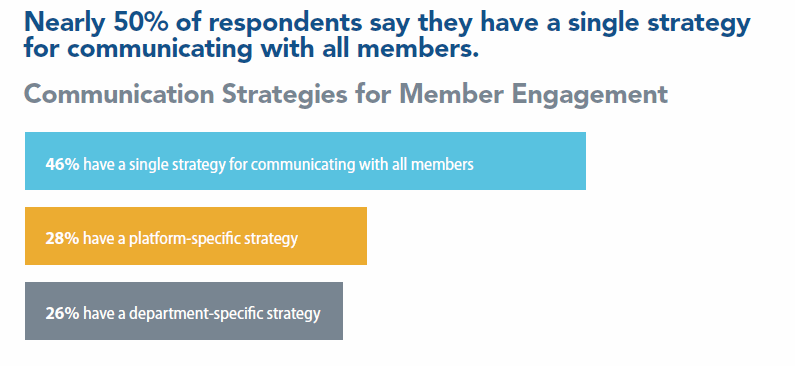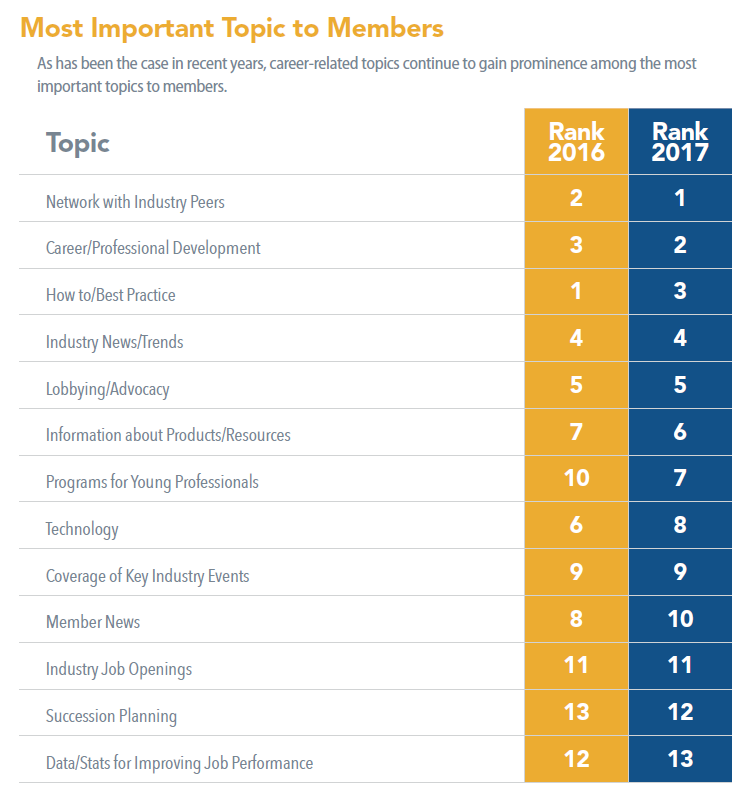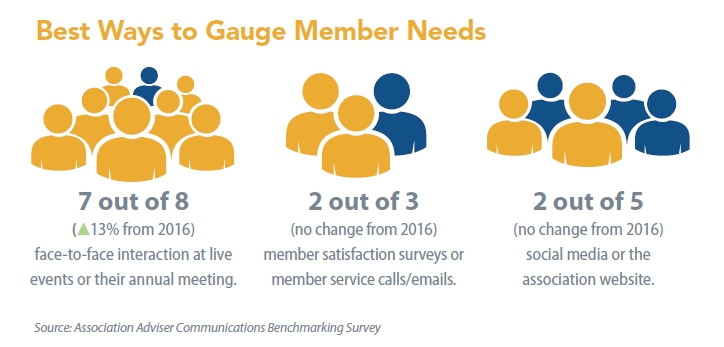Why an Annual Content Plan is Paramount to Member Communication Success
Part 3 of our 2017 Association Communications Benchmarking Study series
Our annual Association Communications Benchmarking Study revealed that nearly 50 percent of survey respondents say they have a single strategy for communicating with all members:

Why is this bad?
Chances are your members interact with your association in more than one way. They attend events, open your emails, visit your website, follow you on social media, watch your videos, and participate in meetings at a frequency and level of involvement that fits their professional role and aspirations at the moment. Not all members prefer to receive communications the same way, at the same time, in the same format.
In short, they want it their way. Selfish? Not really: Catering your association’s member communications to specific member segments’ knowledge levels, device choices and frequency preferences will almost always result in your members paying closer attention to your association’s information. Members who engage more with their association report higher satisfaction with their membership and greater loyalty to their association.
Almost all of the most frequently-cited communication challenges in the study relate to poor planning:
- Communicating member benefits effectively (68 percent of participants cited this challenge) – Is it possible to do this WITHOUT a plan?
- Engaging young professionals (54 percent) – If you don’t communicate to young professionals the way they want to receive information, you will stumble trying to involve them.
- Facilitating member to member communication (40 percent) – Rarely does that just happen.
- Helping members find information quickly (39 percent) – A plan is needed to organize existing content, and easily categorize and organize new content.
- Maintaining position as industry’s No. 1 info source (35 percent) – Being the best resource for industry-specific trends, technologies, leadership tactics and business trends takes planning with a critical eye to any information gaps in an association’s portfolio and a blueprint to fill them.
- Communicating legislative, regulatory, technical updates (30 percent) and keeping members informed about new events and continuing education (30 percent) – A content plan helps your association stay on track covering all areas it needs to within a reasonable time frame.
A comprehensive content plan, done well in advance, forces your association to look at themes you want to cover and communication goals you want to accomplish during a specified time period. This is often thought of as looking at member communications from a bird’s eye or broad perspective.
Listen to NAPA’s Editor and Content Director Monica Dutcher, and GTLA’s Communication Director Ashley Williams discuss the ways they tackle content planning in episode 7 of The Association Adviser Podcast:
Plan to cover all topics
The first step most associations take when forming a content plan is: What topics should we cover? Based on the nature of your industry or profession, you probably know which essential topics must be included for your association to remain relevant.
Take another step and track the types of communications members have recently viewed. Are they engaging with you on career development topics, advocacy topics or peer networking opportunities? Associations must better understand each member’s interests, then send targeted communications about those relevant topics and less information about one-size-fits-all topics that are no longer as relevant to members as they were in previous years.
Once overall content themes are established, your content plan can be broken down into specific topics and assigned to an appropriate content avenue. As you work through your plan, you may decide to add topics that become significant to members, or give less emphasis to topics that have waned in importance since the plan’s creation. It’s a good idea to allow room in your plan for modifications like these. Having a foundational content plan, however, will ensure that over time, your association covers all themes essential to providing the best membership value possible.

What does one theme applied to different member segments and communication platforms look like in practice? For instance, a theme of technology could result in a magazine article geared toward C-suite executives that talks in high-level general terms about technology, while a monthly blog or social media post geared toward younger generations can dive deeper into specific technology trends. Consider the group you’re trying to reach and what’s important to them.
Furthermore, a strong content plan helps your association inventory your existing content and decide what new content you need to develop to fill in any knowledge gaps. An inventory reveals what content should be created, which content needs updating, and which content has reached its retirement point. Viewing your association’s body of content from a high level also reveals the usefulness (or not) of your communication channels – your newsletter that consistently earns high open rates, for example, or your blog that just doesn’t get the traffic you hoped it would. Although the work involved on the front end of conducting a content inventory can be time-consuming, over the long run this regular practice pays off in terms of less time spent overhauling outdated content and stuck with outdated tools. Instead, a well-maintained content inventory allows your communications staff to be more agile in responding to members’ knowledge needs and improving upon already relevant communications.
When your association compares its content inventory against your association’s goals, your communications plan will practically write itself.
Plan to reach all member segments

Your association should create a plan based on member segments. Different groups of members have different information needs: Think younger vs. seasoned members, members with more experience vs. members new to the profession, and members of varying seniority/positions within your association’s industry.
Plan to cover all platforms
Only one in four associations have a department-specific or platform-specific content strategy. Associations consist of many subgroups within their overall membership – if you are not serving the technical, content or frequency needs of members, they will simply not read your content or consider their membership in your association to be as valuable as it should be.
How do you know which platforms your members are using? Ask them! Half of our associations surveyed say they conduct a member communication survey every 12 to 24 months. We recommend surveying your members about what kinds of topics they want information about, through which channels and how often at least once per year. Regular brainstorming sessions by your staff that review survey results will ensure all relevant platforms are in play and reaching your all your members.

Side benefit: If your communications are getting face time with all member segments, the better chance you’ll have of securing contributors to your publications in the future.
Get Started!
Knowing your association’s goals and how member communications contributes to them will set your association on a path of better member engagement and satisfaction. Save your association time and headaches: Create a multi-pronged content plan that gives all members the type of content they are looking for in the communication channel they are looking for it in, and continue to cultivate and grow your membership base.
 Jeanie Clapp is a content strategist with Naylor Association Solutions.
Jeanie Clapp is a content strategist with Naylor Association Solutions.

